Accounting Statement Analysis, Budgeting, and Decision Making
VerifiedAdded on 2023/06/05
|9
|2966
|473
Homework Assignment
AI Summary
This assignment delves into financial statement analysis, covering key concepts like profitability, cost relationships, and budgeting. The student reflects on the importance of financial statement analysis, exploring techniques such as ratio analysis and economic profit. The assignment includes restati...
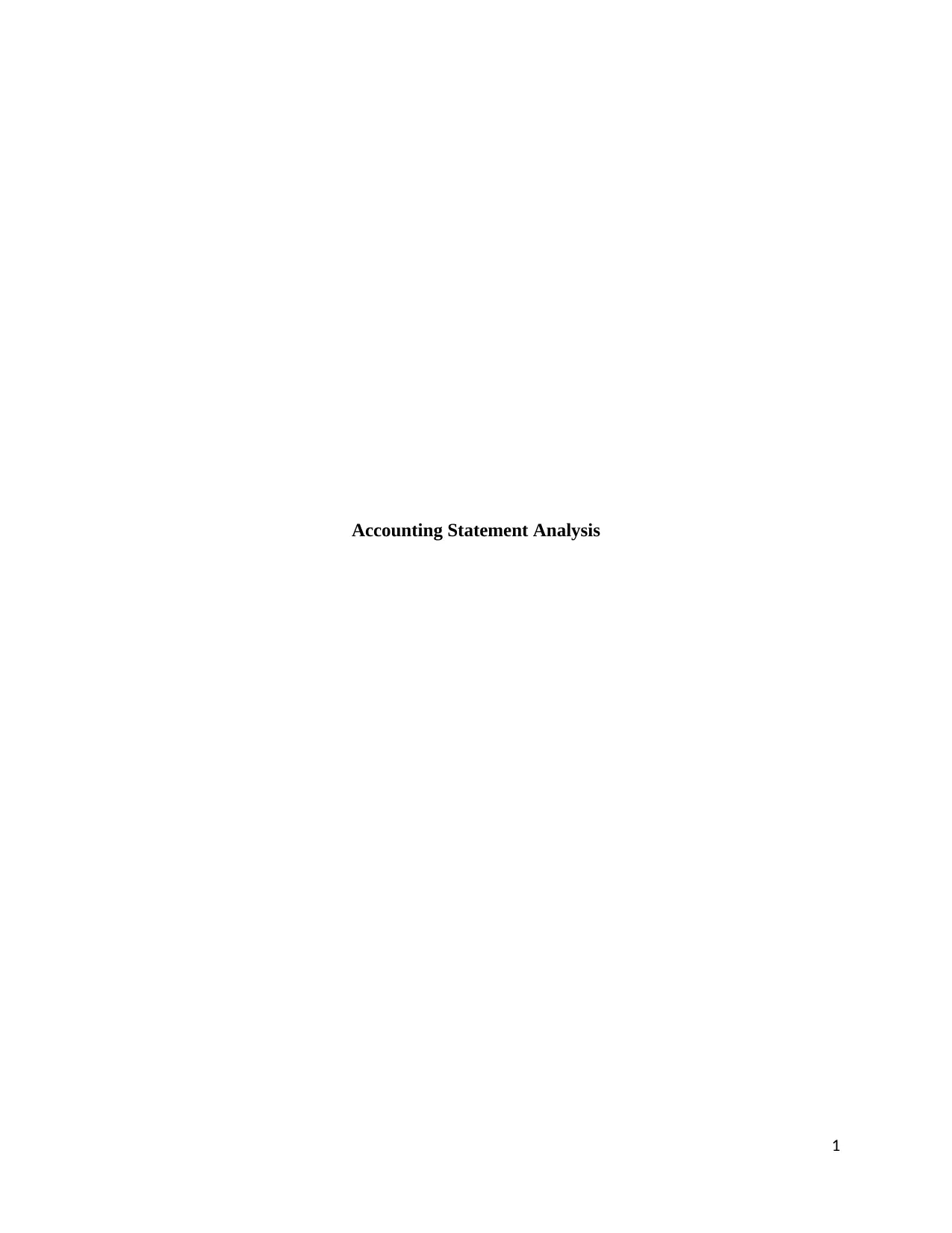
Accounting Statement Analysis
1
1
Paraphrase This Document
Need a fresh take? Get an instant paraphrase of this document with our AI Paraphraser
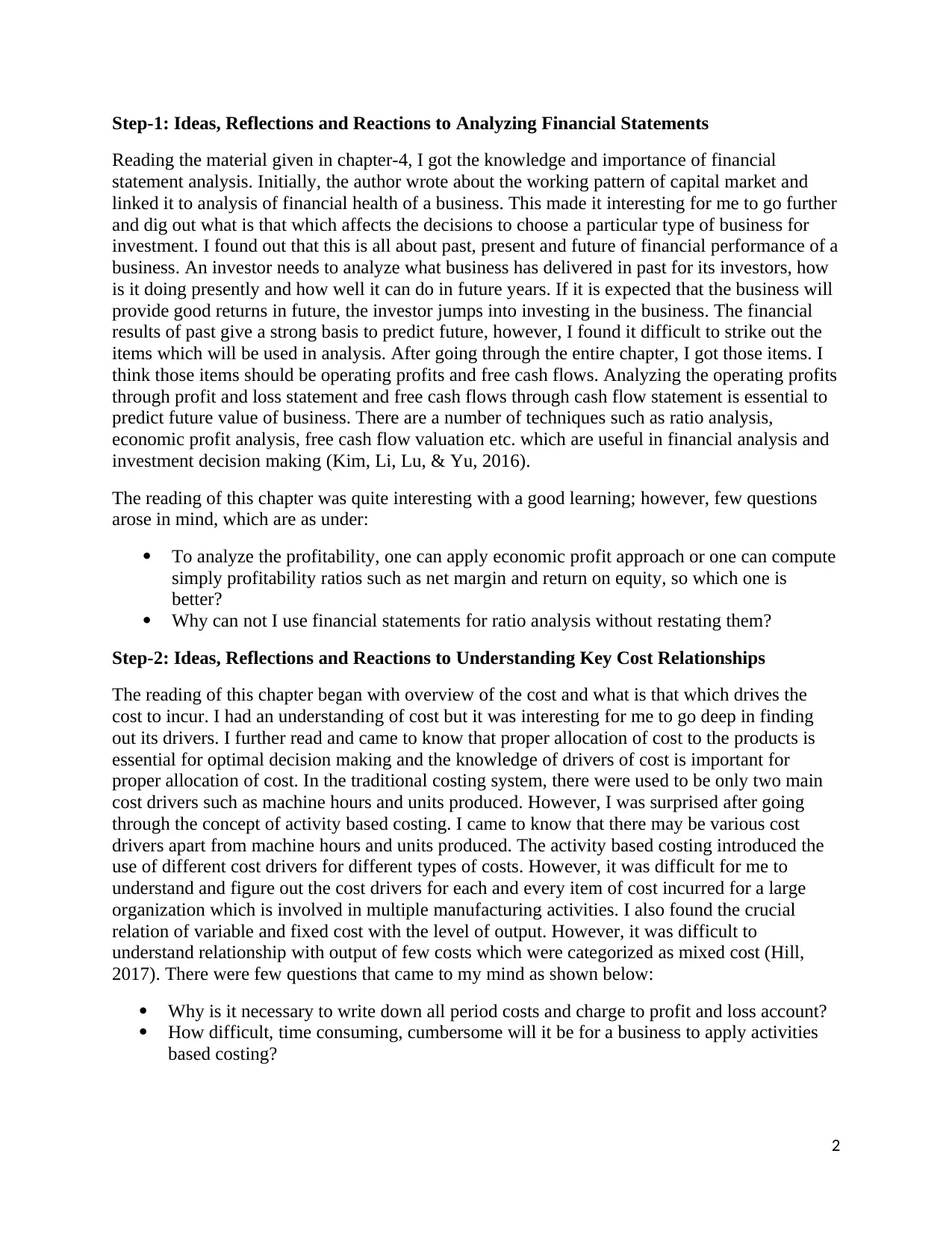
Step-1: Ideas, Reflections and Reactions to Analyzing Financial Statements
Reading the material given in chapter-4, I got the knowledge and importance of financial
statement analysis. Initially, the author wrote about the working pattern of capital market and
linked it to analysis of financial health of a business. This made it interesting for me to go further
and dig out what is that which affects the decisions to choose a particular type of business for
investment. I found out that this is all about past, present and future of financial performance of a
business. An investor needs to analyze what business has delivered in past for its investors, how
is it doing presently and how well it can do in future years. If it is expected that the business will
provide good returns in future, the investor jumps into investing in the business. The financial
results of past give a strong basis to predict future, however, I found it difficult to strike out the
items which will be used in analysis. After going through the entire chapter, I got those items. I
think those items should be operating profits and free cash flows. Analyzing the operating profits
through profit and loss statement and free cash flows through cash flow statement is essential to
predict future value of business. There are a number of techniques such as ratio analysis,
economic profit analysis, free cash flow valuation etc. which are useful in financial analysis and
investment decision making (Kim, Li, Lu, & Yu, 2016).
The reading of this chapter was quite interesting with a good learning; however, few questions
arose in mind, which are as under:
To analyze the profitability, one can apply economic profit approach or one can compute
simply profitability ratios such as net margin and return on equity, so which one is
better?
Why can not I use financial statements for ratio analysis without restating them?
Step-2: Ideas, Reflections and Reactions to Understanding Key Cost Relationships
The reading of this chapter began with overview of the cost and what is that which drives the
cost to incur. I had an understanding of cost but it was interesting for me to go deep in finding
out its drivers. I further read and came to know that proper allocation of cost to the products is
essential for optimal decision making and the knowledge of drivers of cost is important for
proper allocation of cost. In the traditional costing system, there were used to be only two main
cost drivers such as machine hours and units produced. However, I was surprised after going
through the concept of activity based costing. I came to know that there may be various cost
drivers apart from machine hours and units produced. The activity based costing introduced the
use of different cost drivers for different types of costs. However, it was difficult for me to
understand and figure out the cost drivers for each and every item of cost incurred for a large
organization which is involved in multiple manufacturing activities. I also found the crucial
relation of variable and fixed cost with the level of output. However, it was difficult to
understand relationship with output of few costs which were categorized as mixed cost (Hill,
2017). There were few questions that came to my mind as shown below:
Why is it necessary to write down all period costs and charge to profit and loss account?
How difficult, time consuming, cumbersome will it be for a business to apply activities
based costing?
2
Reading the material given in chapter-4, I got the knowledge and importance of financial
statement analysis. Initially, the author wrote about the working pattern of capital market and
linked it to analysis of financial health of a business. This made it interesting for me to go further
and dig out what is that which affects the decisions to choose a particular type of business for
investment. I found out that this is all about past, present and future of financial performance of a
business. An investor needs to analyze what business has delivered in past for its investors, how
is it doing presently and how well it can do in future years. If it is expected that the business will
provide good returns in future, the investor jumps into investing in the business. The financial
results of past give a strong basis to predict future, however, I found it difficult to strike out the
items which will be used in analysis. After going through the entire chapter, I got those items. I
think those items should be operating profits and free cash flows. Analyzing the operating profits
through profit and loss statement and free cash flows through cash flow statement is essential to
predict future value of business. There are a number of techniques such as ratio analysis,
economic profit analysis, free cash flow valuation etc. which are useful in financial analysis and
investment decision making (Kim, Li, Lu, & Yu, 2016).
The reading of this chapter was quite interesting with a good learning; however, few questions
arose in mind, which are as under:
To analyze the profitability, one can apply economic profit approach or one can compute
simply profitability ratios such as net margin and return on equity, so which one is
better?
Why can not I use financial statements for ratio analysis without restating them?
Step-2: Ideas, Reflections and Reactions to Understanding Key Cost Relationships
The reading of this chapter began with overview of the cost and what is that which drives the
cost to incur. I had an understanding of cost but it was interesting for me to go deep in finding
out its drivers. I further read and came to know that proper allocation of cost to the products is
essential for optimal decision making and the knowledge of drivers of cost is important for
proper allocation of cost. In the traditional costing system, there were used to be only two main
cost drivers such as machine hours and units produced. However, I was surprised after going
through the concept of activity based costing. I came to know that there may be various cost
drivers apart from machine hours and units produced. The activity based costing introduced the
use of different cost drivers for different types of costs. However, it was difficult for me to
understand and figure out the cost drivers for each and every item of cost incurred for a large
organization which is involved in multiple manufacturing activities. I also found the crucial
relation of variable and fixed cost with the level of output. However, it was difficult to
understand relationship with output of few costs which were categorized as mixed cost (Hill,
2017). There were few questions that came to my mind as shown below:
Why is it necessary to write down all period costs and charge to profit and loss account?
How difficult, time consuming, cumbersome will it be for a business to apply activities
based costing?
2
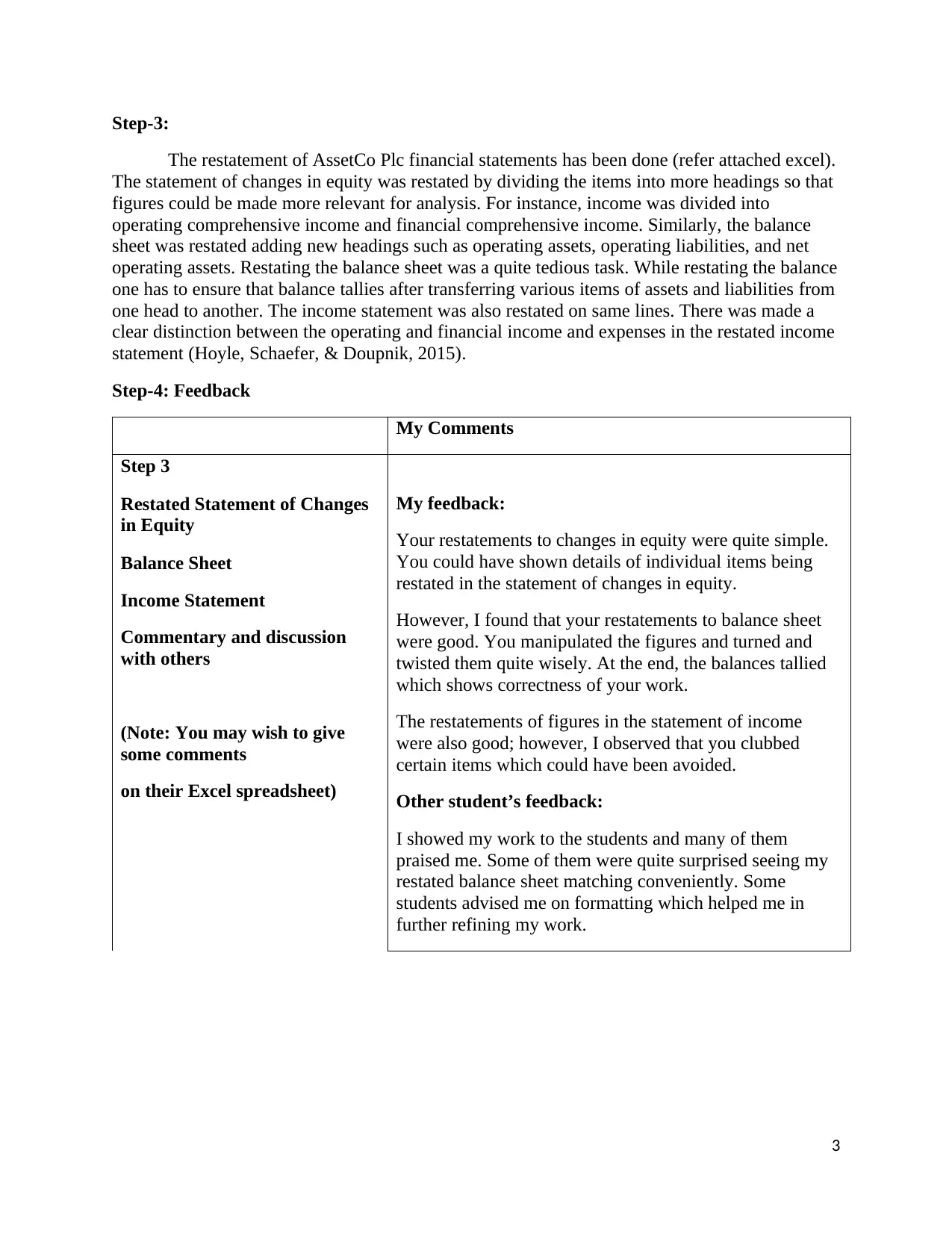
Step-3:
The restatement of AssetCo Plc financial statements has been done (refer attached excel).
The statement of changes in equity was restated by dividing the items into more headings so that
figures could be made more relevant for analysis. For instance, income was divided into
operating comprehensive income and financial comprehensive income. Similarly, the balance
sheet was restated adding new headings such as operating assets, operating liabilities, and net
operating assets. Restating the balance sheet was a quite tedious task. While restating the balance
one has to ensure that balance tallies after transferring various items of assets and liabilities from
one head to another. The income statement was also restated on same lines. There was made a
clear distinction between the operating and financial income and expenses in the restated income
statement (Hoyle, Schaefer, & Doupnik, 2015).
Step-4: Feedback
My Comments
Step 3
My feedback:
Your restatements to changes in equity were quite simple.
You could have shown details of individual items being
restated in the statement of changes in equity.
However, I found that your restatements to balance sheet
were good. You manipulated the figures and turned and
twisted them quite wisely. At the end, the balances tallied
which shows correctness of your work.
The restatements of figures in the statement of income
were also good; however, I observed that you clubbed
certain items which could have been avoided.
Other student’s feedback:
I showed my work to the students and many of them
praised me. Some of them were quite surprised seeing my
restated balance sheet matching conveniently. Some
students advised me on formatting which helped me in
further refining my work.
Restated Statement of Changes
in Equity
Balance Sheet
Income Statement
Commentary and discussion
with others
(Note: You may wish to give
some comments
on their Excel spreadsheet)
3
The restatement of AssetCo Plc financial statements has been done (refer attached excel).
The statement of changes in equity was restated by dividing the items into more headings so that
figures could be made more relevant for analysis. For instance, income was divided into
operating comprehensive income and financial comprehensive income. Similarly, the balance
sheet was restated adding new headings such as operating assets, operating liabilities, and net
operating assets. Restating the balance sheet was a quite tedious task. While restating the balance
one has to ensure that balance tallies after transferring various items of assets and liabilities from
one head to another. The income statement was also restated on same lines. There was made a
clear distinction between the operating and financial income and expenses in the restated income
statement (Hoyle, Schaefer, & Doupnik, 2015).
Step-4: Feedback
My Comments
Step 3
My feedback:
Your restatements to changes in equity were quite simple.
You could have shown details of individual items being
restated in the statement of changes in equity.
However, I found that your restatements to balance sheet
were good. You manipulated the figures and turned and
twisted them quite wisely. At the end, the balances tallied
which shows correctness of your work.
The restatements of figures in the statement of income
were also good; however, I observed that you clubbed
certain items which could have been avoided.
Other student’s feedback:
I showed my work to the students and many of them
praised me. Some of them were quite surprised seeing my
restated balance sheet matching conveniently. Some
students advised me on formatting which helped me in
further refining my work.
Restated Statement of Changes
in Equity
Balance Sheet
Income Statement
Commentary and discussion
with others
(Note: You may wish to give
some comments
on their Excel spreadsheet)
3
⊘ This is a preview!⊘
Do you want full access?
Subscribe today to unlock all pages.

Trusted by 1+ million students worldwide
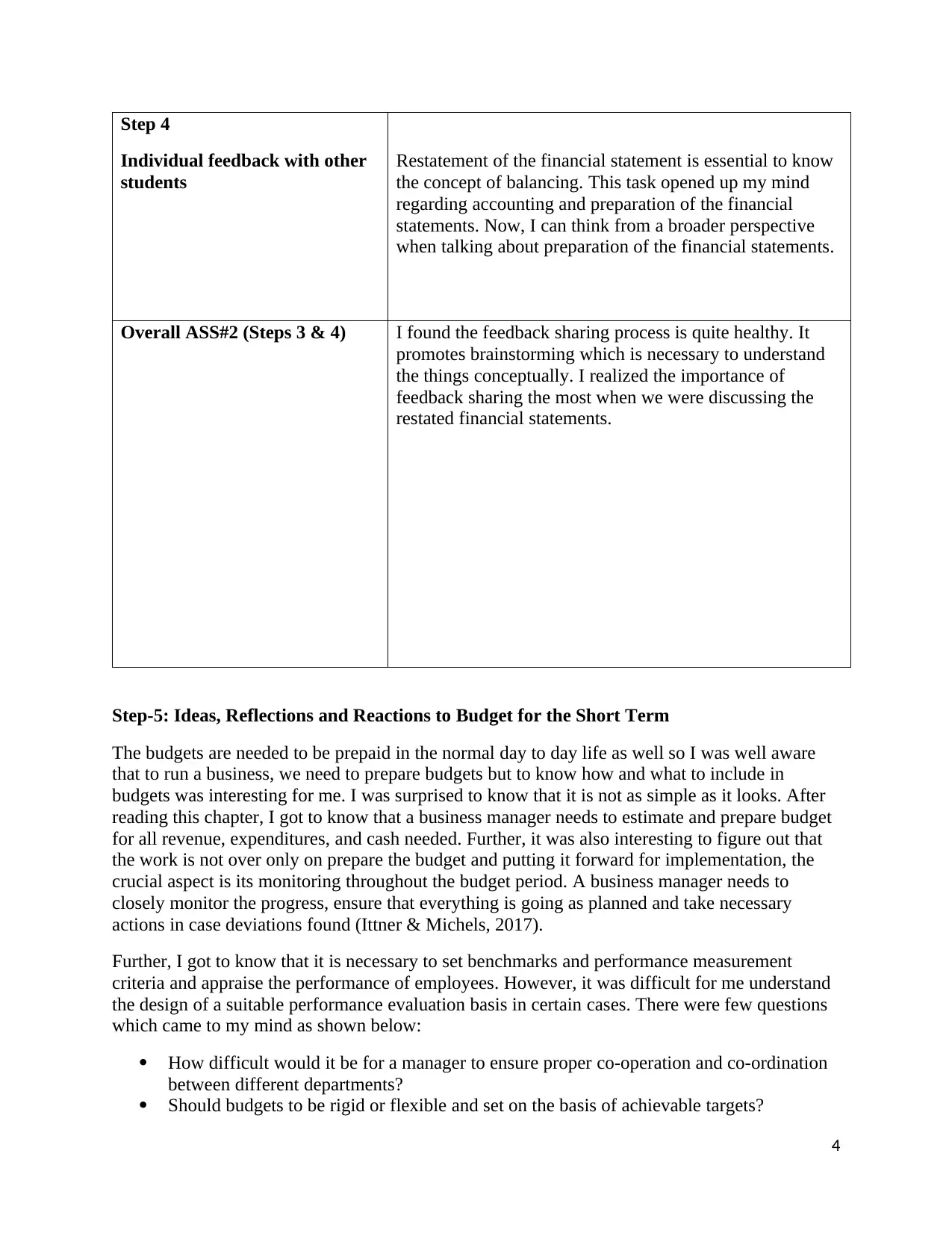
Step 4
Individual feedback with other
students
Restatement of the financial statement is essential to know
the concept of balancing. This task opened up my mind
regarding accounting and preparation of the financial
statements. Now, I can think from a broader perspective
when talking about preparation of the financial statements.
Overall ASS#2 (Steps 3 & 4) I found the feedback sharing process is quite healthy. It
promotes brainstorming which is necessary to understand
the things conceptually. I realized the importance of
feedback sharing the most when we were discussing the
restated financial statements.
Step-5: Ideas, Reflections and Reactions to Budget for the Short Term
The budgets are needed to be prepaid in the normal day to day life as well so I was well aware
that to run a business, we need to prepare budgets but to know how and what to include in
budgets was interesting for me. I was surprised to know that it is not as simple as it looks. After
reading this chapter, I got to know that a business manager needs to estimate and prepare budget
for all revenue, expenditures, and cash needed. Further, it was also interesting to figure out that
the work is not over only on prepare the budget and putting it forward for implementation, the
crucial aspect is its monitoring throughout the budget period. A business manager needs to
closely monitor the progress, ensure that everything is going as planned and take necessary
actions in case deviations found (Ittner & Michels, 2017).
Further, I got to know that it is necessary to set benchmarks and performance measurement
criteria and appraise the performance of employees. However, it was difficult for me understand
the design of a suitable performance evaluation basis in certain cases. There were few questions
which came to my mind as shown below:
How difficult would it be for a manager to ensure proper co-operation and co-ordination
between different departments?
Should budgets to be rigid or flexible and set on the basis of achievable targets?
4
Individual feedback with other
students
Restatement of the financial statement is essential to know
the concept of balancing. This task opened up my mind
regarding accounting and preparation of the financial
statements. Now, I can think from a broader perspective
when talking about preparation of the financial statements.
Overall ASS#2 (Steps 3 & 4) I found the feedback sharing process is quite healthy. It
promotes brainstorming which is necessary to understand
the things conceptually. I realized the importance of
feedback sharing the most when we were discussing the
restated financial statements.
Step-5: Ideas, Reflections and Reactions to Budget for the Short Term
The budgets are needed to be prepaid in the normal day to day life as well so I was well aware
that to run a business, we need to prepare budgets but to know how and what to include in
budgets was interesting for me. I was surprised to know that it is not as simple as it looks. After
reading this chapter, I got to know that a business manager needs to estimate and prepare budget
for all revenue, expenditures, and cash needed. Further, it was also interesting to figure out that
the work is not over only on prepare the budget and putting it forward for implementation, the
crucial aspect is its monitoring throughout the budget period. A business manager needs to
closely monitor the progress, ensure that everything is going as planned and take necessary
actions in case deviations found (Ittner & Michels, 2017).
Further, I got to know that it is necessary to set benchmarks and performance measurement
criteria and appraise the performance of employees. However, it was difficult for me understand
the design of a suitable performance evaluation basis in certain cases. There were few questions
which came to my mind as shown below:
How difficult would it be for a manager to ensure proper co-operation and co-ordination
between different departments?
Should budgets to be rigid or flexible and set on the basis of achievable targets?
4
Paraphrase This Document
Need a fresh take? Get an instant paraphrase of this document with our AI Paraphraser
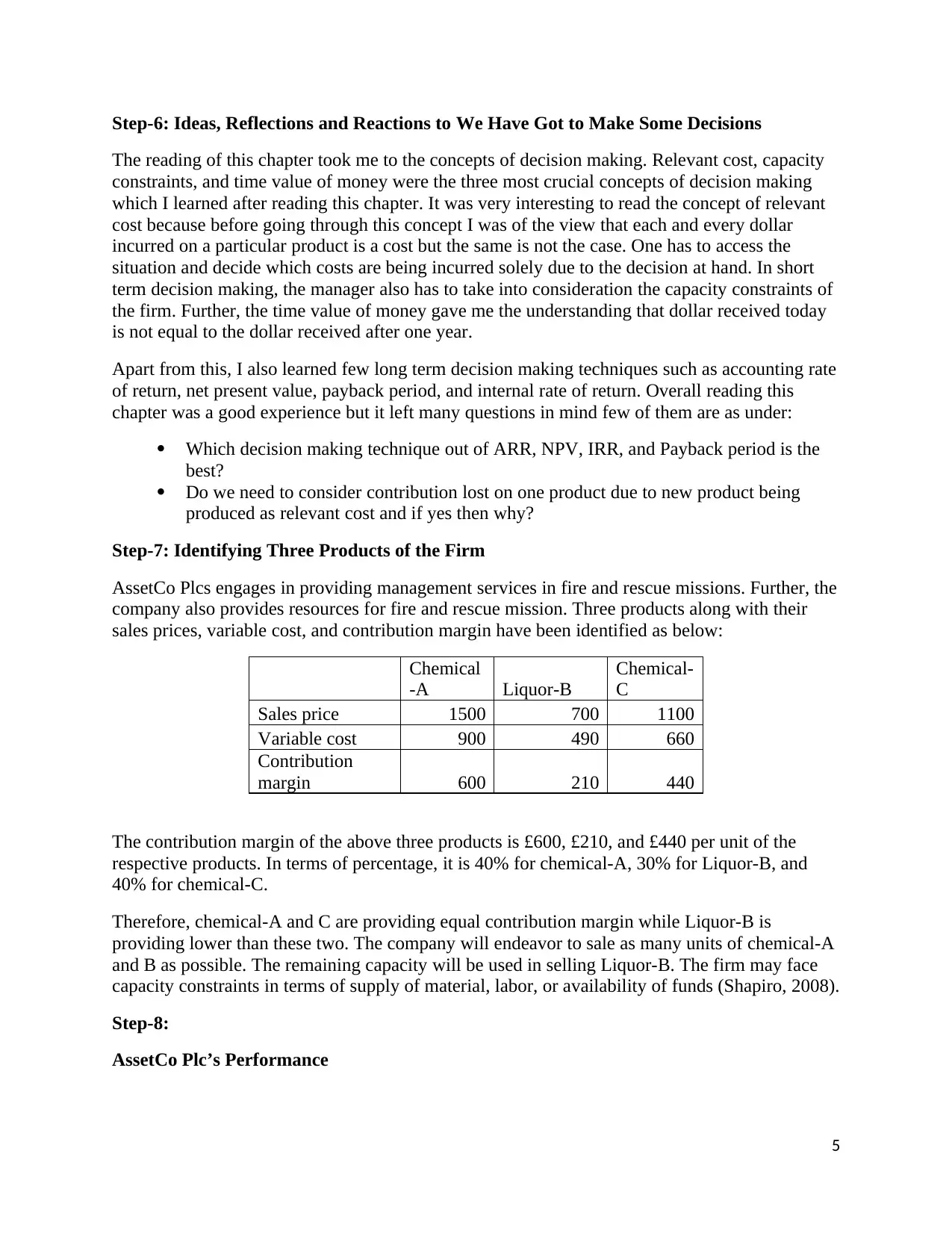
Step-6: Ideas, Reflections and Reactions to We Have Got to Make Some Decisions
The reading of this chapter took me to the concepts of decision making. Relevant cost, capacity
constraints, and time value of money were the three most crucial concepts of decision making
which I learned after reading this chapter. It was very interesting to read the concept of relevant
cost because before going through this concept I was of the view that each and every dollar
incurred on a particular product is a cost but the same is not the case. One has to access the
situation and decide which costs are being incurred solely due to the decision at hand. In short
term decision making, the manager also has to take into consideration the capacity constraints of
the firm. Further, the time value of money gave me the understanding that dollar received today
is not equal to the dollar received after one year.
Apart from this, I also learned few long term decision making techniques such as accounting rate
of return, net present value, payback period, and internal rate of return. Overall reading this
chapter was a good experience but it left many questions in mind few of them are as under:
Which decision making technique out of ARR, NPV, IRR, and Payback period is the
best?
Do we need to consider contribution lost on one product due to new product being
produced as relevant cost and if yes then why?
Step-7: Identifying Three Products of the Firm
AssetCo Plcs engages in providing management services in fire and rescue missions. Further, the
company also provides resources for fire and rescue mission. Three products along with their
sales prices, variable cost, and contribution margin have been identified as below:
Chemical
-A Liquor-B
Chemical-
C
Sales price 1500 700 1100
Variable cost 900 490 660
Contribution
margin 600 210 440
The contribution margin of the above three products is £600, £210, and £440 per unit of the
respective products. In terms of percentage, it is 40% for chemical-A, 30% for Liquor-B, and
40% for chemical-C.
Therefore, chemical-A and C are providing equal contribution margin while Liquor-B is
providing lower than these two. The company will endeavor to sale as many units of chemical-A
and B as possible. The remaining capacity will be used in selling Liquor-B. The firm may face
capacity constraints in terms of supply of material, labor, or availability of funds (Shapiro, 2008).
Step-8:
AssetCo Plc’s Performance
5
The reading of this chapter took me to the concepts of decision making. Relevant cost, capacity
constraints, and time value of money were the three most crucial concepts of decision making
which I learned after reading this chapter. It was very interesting to read the concept of relevant
cost because before going through this concept I was of the view that each and every dollar
incurred on a particular product is a cost but the same is not the case. One has to access the
situation and decide which costs are being incurred solely due to the decision at hand. In short
term decision making, the manager also has to take into consideration the capacity constraints of
the firm. Further, the time value of money gave me the understanding that dollar received today
is not equal to the dollar received after one year.
Apart from this, I also learned few long term decision making techniques such as accounting rate
of return, net present value, payback period, and internal rate of return. Overall reading this
chapter was a good experience but it left many questions in mind few of them are as under:
Which decision making technique out of ARR, NPV, IRR, and Payback period is the
best?
Do we need to consider contribution lost on one product due to new product being
produced as relevant cost and if yes then why?
Step-7: Identifying Three Products of the Firm
AssetCo Plcs engages in providing management services in fire and rescue missions. Further, the
company also provides resources for fire and rescue mission. Three products along with their
sales prices, variable cost, and contribution margin have been identified as below:
Chemical
-A Liquor-B
Chemical-
C
Sales price 1500 700 1100
Variable cost 900 490 660
Contribution
margin 600 210 440
The contribution margin of the above three products is £600, £210, and £440 per unit of the
respective products. In terms of percentage, it is 40% for chemical-A, 30% for Liquor-B, and
40% for chemical-C.
Therefore, chemical-A and C are providing equal contribution margin while Liquor-B is
providing lower than these two. The company will endeavor to sale as many units of chemical-A
and B as possible. The remaining capacity will be used in selling Liquor-B. The firm may face
capacity constraints in terms of supply of material, labor, or availability of funds (Shapiro, 2008).
Step-8:
AssetCo Plc’s Performance
5
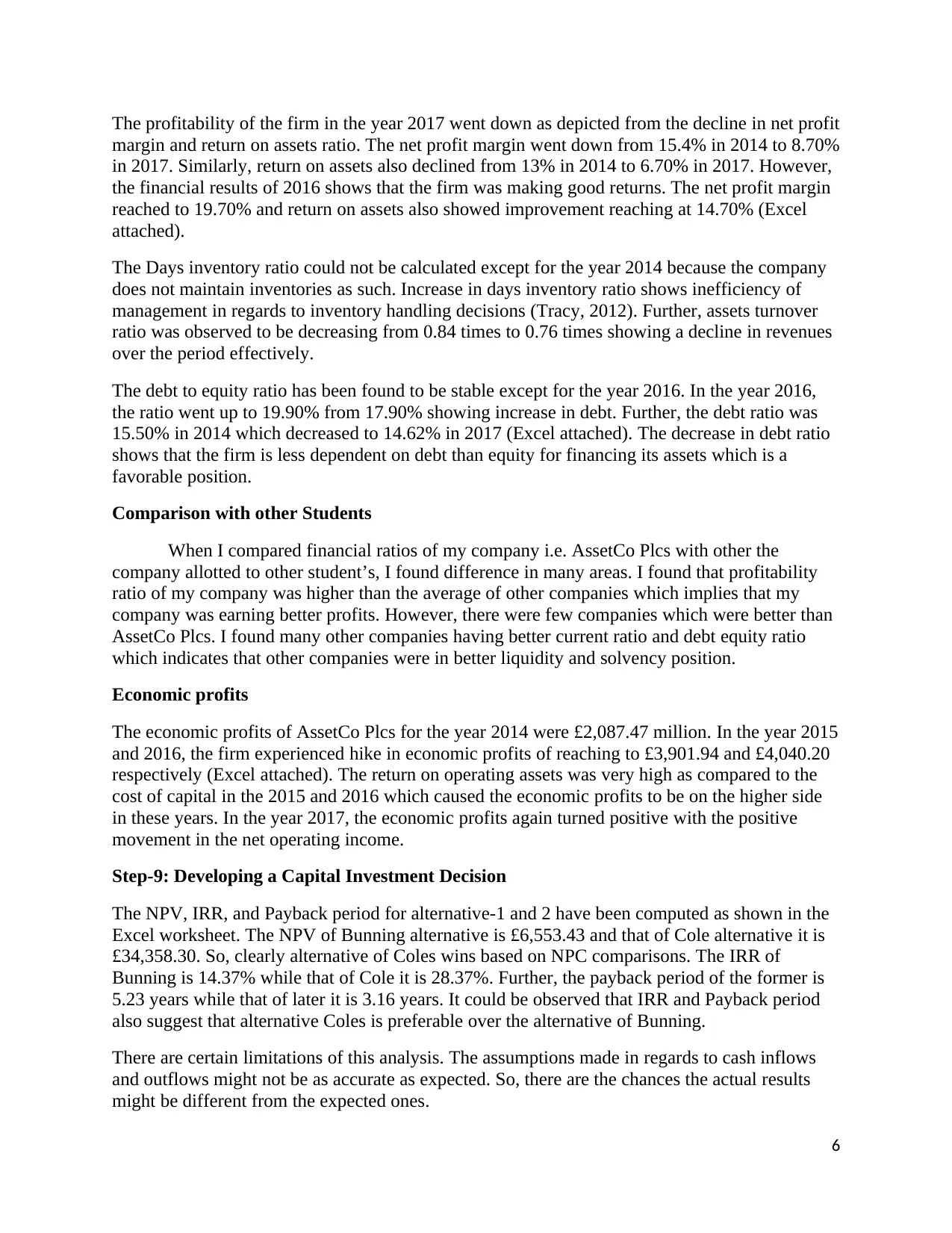
The profitability of the firm in the year 2017 went down as depicted from the decline in net profit
margin and return on assets ratio. The net profit margin went down from 15.4% in 2014 to 8.70%
in 2017. Similarly, return on assets also declined from 13% in 2014 to 6.70% in 2017. However,
the financial results of 2016 shows that the firm was making good returns. The net profit margin
reached to 19.70% and return on assets also showed improvement reaching at 14.70% (Excel
attached).
The Days inventory ratio could not be calculated except for the year 2014 because the company
does not maintain inventories as such. Increase in days inventory ratio shows inefficiency of
management in regards to inventory handling decisions (Tracy, 2012). Further, assets turnover
ratio was observed to be decreasing from 0.84 times to 0.76 times showing a decline in revenues
over the period effectively.
The debt to equity ratio has been found to be stable except for the year 2016. In the year 2016,
the ratio went up to 19.90% from 17.90% showing increase in debt. Further, the debt ratio was
15.50% in 2014 which decreased to 14.62% in 2017 (Excel attached). The decrease in debt ratio
shows that the firm is less dependent on debt than equity for financing its assets which is a
favorable position.
Comparison with other Students
When I compared financial ratios of my company i.e. AssetCo Plcs with other the
company allotted to other student’s, I found difference in many areas. I found that profitability
ratio of my company was higher than the average of other companies which implies that my
company was earning better profits. However, there were few companies which were better than
AssetCo Plcs. I found many other companies having better current ratio and debt equity ratio
which indicates that other companies were in better liquidity and solvency position.
Economic profits
The economic profits of AssetCo Plcs for the year 2014 were £2,087.47 million. In the year 2015
and 2016, the firm experienced hike in economic profits of reaching to £3,901.94 and £4,040.20
respectively (Excel attached). The return on operating assets was very high as compared to the
cost of capital in the 2015 and 2016 which caused the economic profits to be on the higher side
in these years. In the year 2017, the economic profits again turned positive with the positive
movement in the net operating income.
Step-9: Developing a Capital Investment Decision
The NPV, IRR, and Payback period for alternative-1 and 2 have been computed as shown in the
Excel worksheet. The NPV of Bunning alternative is £6,553.43 and that of Cole alternative it is
£34,358.30. So, clearly alternative of Coles wins based on NPC comparisons. The IRR of
Bunning is 14.37% while that of Cole it is 28.37%. Further, the payback period of the former is
5.23 years while that of later it is 3.16 years. It could be observed that IRR and Payback period
also suggest that alternative Coles is preferable over the alternative of Bunning.
There are certain limitations of this analysis. The assumptions made in regards to cash inflows
and outflows might not be as accurate as expected. So, there are the chances the actual results
might be different from the expected ones.
6
margin and return on assets ratio. The net profit margin went down from 15.4% in 2014 to 8.70%
in 2017. Similarly, return on assets also declined from 13% in 2014 to 6.70% in 2017. However,
the financial results of 2016 shows that the firm was making good returns. The net profit margin
reached to 19.70% and return on assets also showed improvement reaching at 14.70% (Excel
attached).
The Days inventory ratio could not be calculated except for the year 2014 because the company
does not maintain inventories as such. Increase in days inventory ratio shows inefficiency of
management in regards to inventory handling decisions (Tracy, 2012). Further, assets turnover
ratio was observed to be decreasing from 0.84 times to 0.76 times showing a decline in revenues
over the period effectively.
The debt to equity ratio has been found to be stable except for the year 2016. In the year 2016,
the ratio went up to 19.90% from 17.90% showing increase in debt. Further, the debt ratio was
15.50% in 2014 which decreased to 14.62% in 2017 (Excel attached). The decrease in debt ratio
shows that the firm is less dependent on debt than equity for financing its assets which is a
favorable position.
Comparison with other Students
When I compared financial ratios of my company i.e. AssetCo Plcs with other the
company allotted to other student’s, I found difference in many areas. I found that profitability
ratio of my company was higher than the average of other companies which implies that my
company was earning better profits. However, there were few companies which were better than
AssetCo Plcs. I found many other companies having better current ratio and debt equity ratio
which indicates that other companies were in better liquidity and solvency position.
Economic profits
The economic profits of AssetCo Plcs for the year 2014 were £2,087.47 million. In the year 2015
and 2016, the firm experienced hike in economic profits of reaching to £3,901.94 and £4,040.20
respectively (Excel attached). The return on operating assets was very high as compared to the
cost of capital in the 2015 and 2016 which caused the economic profits to be on the higher side
in these years. In the year 2017, the economic profits again turned positive with the positive
movement in the net operating income.
Step-9: Developing a Capital Investment Decision
The NPV, IRR, and Payback period for alternative-1 and 2 have been computed as shown in the
Excel worksheet. The NPV of Bunning alternative is £6,553.43 and that of Cole alternative it is
£34,358.30. So, clearly alternative of Coles wins based on NPC comparisons. The IRR of
Bunning is 14.37% while that of Cole it is 28.37%. Further, the payback period of the former is
5.23 years while that of later it is 3.16 years. It could be observed that IRR and Payback period
also suggest that alternative Coles is preferable over the alternative of Bunning.
There are certain limitations of this analysis. The assumptions made in regards to cash inflows
and outflows might not be as accurate as expected. So, there are the chances the actual results
might be different from the expected ones.
6
⊘ This is a preview!⊘
Do you want full access?
Subscribe today to unlock all pages.

Trusted by 1+ million students worldwide
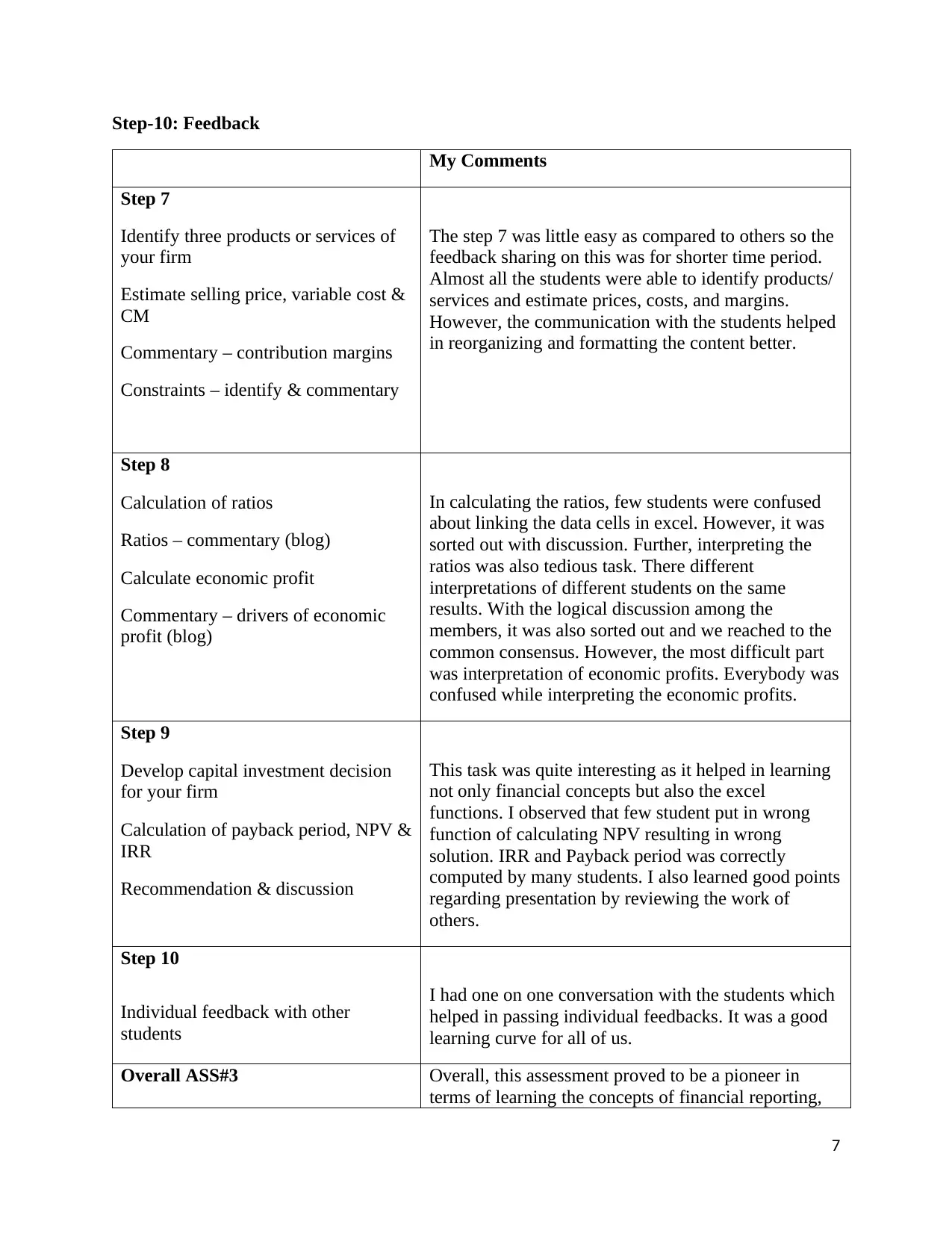
Step-10: Feedback
My Comments
Step 7
Identify three products or services of
your firm
Estimate selling price, variable cost &
CM
Commentary – contribution margins
Constraints – identify & commentary
The step 7 was little easy as compared to others so the
feedback sharing on this was for shorter time period.
Almost all the students were able to identify products/
services and estimate prices, costs, and margins.
However, the communication with the students helped
in reorganizing and formatting the content better.
Step 8
In calculating the ratios, few students were confused
about linking the data cells in excel. However, it was
sorted out with discussion. Further, interpreting the
ratios was also tedious task. There different
interpretations of different students on the same
results. With the logical discussion among the
members, it was also sorted out and we reached to the
common consensus. However, the most difficult part
was interpretation of economic profits. Everybody was
confused while interpreting the economic profits.
Calculation of ratios
Ratios – commentary (blog)
Calculate economic profit
Commentary – drivers of economic
profit (blog)
Step 9
This task was quite interesting as it helped in learning
not only financial concepts but also the excel
functions. I observed that few student put in wrong
function of calculating NPV resulting in wrong
solution. IRR and Payback period was correctly
computed by many students. I also learned good points
regarding presentation by reviewing the work of
others.
Develop capital investment decision
for your firm
Calculation of payback period, NPV &
IRR
Recommendation & discussion
Step 10
I had one on one conversation with the students which
helped in passing individual feedbacks. It was a good
learning curve for all of us.
Individual feedback with other
students
Overall ASS#3 Overall, this assessment proved to be a pioneer in
terms of learning the concepts of financial reporting,
7
My Comments
Step 7
Identify three products or services of
your firm
Estimate selling price, variable cost &
CM
Commentary – contribution margins
Constraints – identify & commentary
The step 7 was little easy as compared to others so the
feedback sharing on this was for shorter time period.
Almost all the students were able to identify products/
services and estimate prices, costs, and margins.
However, the communication with the students helped
in reorganizing and formatting the content better.
Step 8
In calculating the ratios, few students were confused
about linking the data cells in excel. However, it was
sorted out with discussion. Further, interpreting the
ratios was also tedious task. There different
interpretations of different students on the same
results. With the logical discussion among the
members, it was also sorted out and we reached to the
common consensus. However, the most difficult part
was interpretation of economic profits. Everybody was
confused while interpreting the economic profits.
Calculation of ratios
Ratios – commentary (blog)
Calculate economic profit
Commentary – drivers of economic
profit (blog)
Step 9
This task was quite interesting as it helped in learning
not only financial concepts but also the excel
functions. I observed that few student put in wrong
function of calculating NPV resulting in wrong
solution. IRR and Payback period was correctly
computed by many students. I also learned good points
regarding presentation by reviewing the work of
others.
Develop capital investment decision
for your firm
Calculation of payback period, NPV &
IRR
Recommendation & discussion
Step 10
I had one on one conversation with the students which
helped in passing individual feedbacks. It was a good
learning curve for all of us.
Individual feedback with other
students
Overall ASS#3 Overall, this assessment proved to be a pioneer in
terms of learning the concepts of financial reporting,
7
Paraphrase This Document
Need a fresh take? Get an instant paraphrase of this document with our AI Paraphraser

financial analysis, and capital budgeting.
8
8
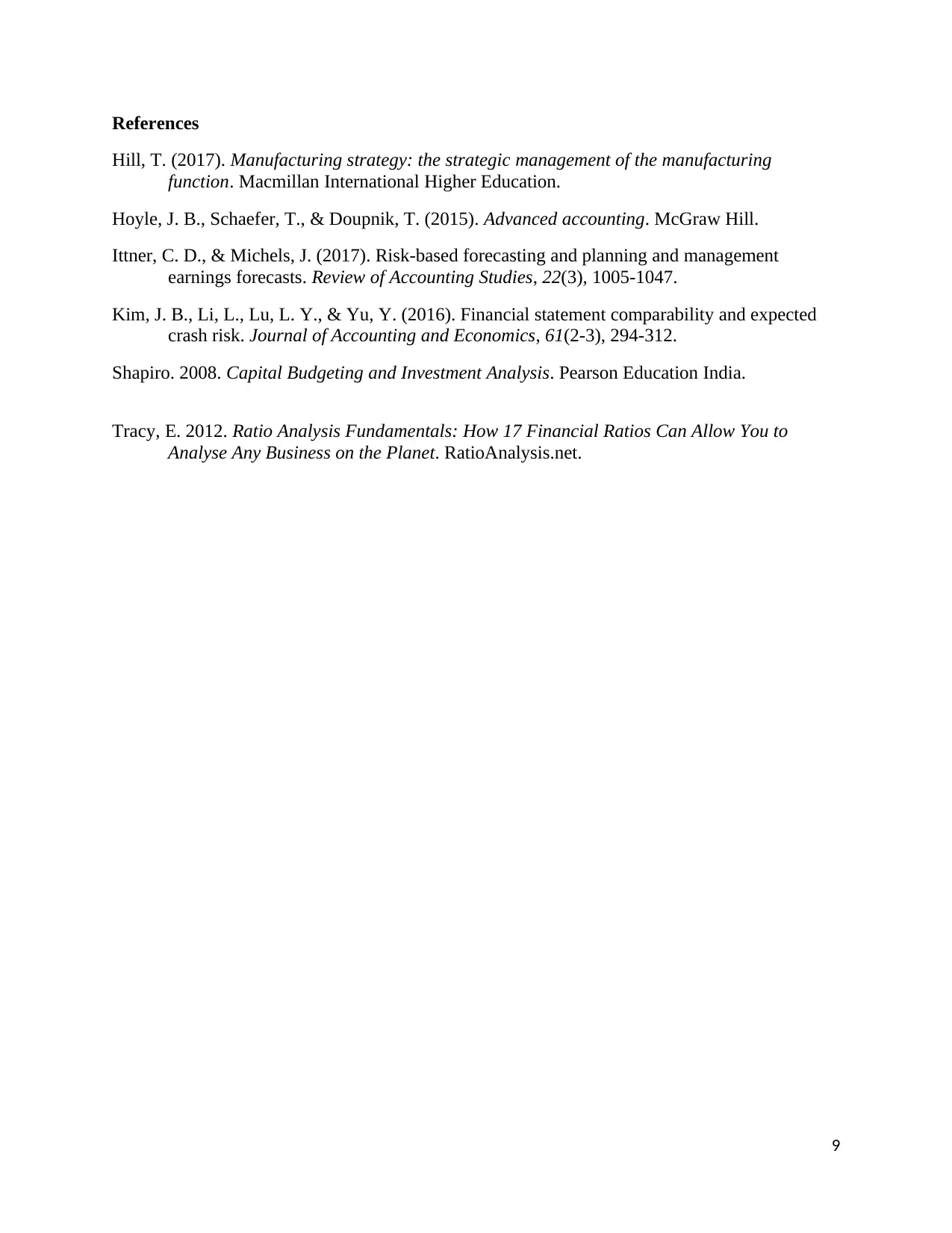
References
Hill, T. (2017). Manufacturing strategy: the strategic management of the manufacturing
function. Macmillan International Higher Education.
Hoyle, J. B., Schaefer, T., & Doupnik, T. (2015). Advanced accounting. McGraw Hill.
Ittner, C. D., & Michels, J. (2017). Risk-based forecasting and planning and management
earnings forecasts. Review of Accounting Studies, 22(3), 1005-1047.
Kim, J. B., Li, L., Lu, L. Y., & Yu, Y. (2016). Financial statement comparability and expected
crash risk. Journal of Accounting and Economics, 61(2-3), 294-312.
Shapiro. 2008. Capital Budgeting and Investment Analysis. Pearson Education India.
Tracy, E. 2012. Ratio Analysis Fundamentals: How 17 Financial Ratios Can Allow You to
Analyse Any Business on the Planet. RatioAnalysis.net.
9
Hill, T. (2017). Manufacturing strategy: the strategic management of the manufacturing
function. Macmillan International Higher Education.
Hoyle, J. B., Schaefer, T., & Doupnik, T. (2015). Advanced accounting. McGraw Hill.
Ittner, C. D., & Michels, J. (2017). Risk-based forecasting and planning and management
earnings forecasts. Review of Accounting Studies, 22(3), 1005-1047.
Kim, J. B., Li, L., Lu, L. Y., & Yu, Y. (2016). Financial statement comparability and expected
crash risk. Journal of Accounting and Economics, 61(2-3), 294-312.
Shapiro. 2008. Capital Budgeting and Investment Analysis. Pearson Education India.
Tracy, E. 2012. Ratio Analysis Fundamentals: How 17 Financial Ratios Can Allow You to
Analyse Any Business on the Planet. RatioAnalysis.net.
9
⊘ This is a preview!⊘
Do you want full access?
Subscribe today to unlock all pages.

Trusted by 1+ million students worldwide
1 out of 9
Related Documents
Your All-in-One AI-Powered Toolkit for Academic Success.
+13062052269
info@desklib.com
Available 24*7 on WhatsApp / Email
![[object Object]](/_next/static/media/star-bottom.7253800d.svg)
Unlock your academic potential
© 2024 | Zucol Services PVT LTD | All rights reserved.

![Financial Statement Analysis Homework - [University Name] - Semester 1](/_next/image/?url=https%3A%2F%2Fdesklib.com%2Fmedia%2Fimages%2Fpl%2F94032add73c5467f81c103edfc1a6f31.jpg&w=256&q=75)



